William Davis's Blog: Dr. Davis Infinite Health Blog, page 53
February 20, 2019
Could that rash be from wheat?
Grains can play havoc with your skin. The prolamin proteins, such as gliadin, trigger autoimmune skin reactions and turn antibodies against the skin enzymes, their lectins fan the fires of inflammation, their proteins provoke allergies, and their amylopectins send blood sugar and insulin sky-high and provoke the skin-disrupting hormone insulin-like growth factor-1 (IGF). The whole grain package adds up to an impressive collection of skin conditions that can take a variety of forms, from simple red, itchy rashes to scaly, oily raised patches to large vesicles to gangrene. Because hair and nails are also considered part of the integumentary system, they, too, can be involved.
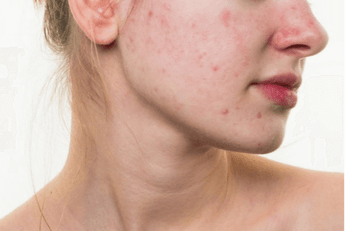 ACNE – Acne is a nearly universal problem in modern teenagers and adults. It is believed that acne is provoked by foods that trigger insulin and the hormone IGF. All grains raise blood sugar, and thereby insulin and IGF, to high levels, so they all share the capacity to create facial havoc. Sugary foods, such as soft drinks and candy also trigger insulin and IGF and can therefore share the blame as can the whey protein of dairy products that is unique among dairy components in its capacity to trigger insulin and IGF. Repetitive high blood sugars lead to repetitive high insulin and IGF, which causes progressive resistance to insulin, leading to higher levels of insulin and IGF. This cycle promotes acne.
ACNE – Acne is a nearly universal problem in modern teenagers and adults. It is believed that acne is provoked by foods that trigger insulin and the hormone IGF. All grains raise blood sugar, and thereby insulin and IGF, to high levels, so they all share the capacity to create facial havoc. Sugary foods, such as soft drinks and candy also trigger insulin and IGF and can therefore share the blame as can the whey protein of dairy products that is unique among dairy components in its capacity to trigger insulin and IGF. Repetitive high blood sugars lead to repetitive high insulin and IGF, which causes progressive resistance to insulin, leading to higher levels of insulin and IGF. This cycle promotes acne.
SEBORRHEA – This common red rash typically occurs along the sides of the nose and on the eyebrows, chest, back, and scalp (where it is called dandruff). The Malassezia fungus causes this rash. Interestingly, the same fungus populates the skin of most humans, even if they don’t have seborrhea. The relationship between grains and seborrhea is exceptionally consistent and predictable. Seborrhea is very common in grain consumers. It is also uncommon for seborrhea to not to improve or completely disappear with wheat elimination. In fact I will go so far as to say that seborrhea, especially along both sides of the nose, is the signature skin rash of grain consumption, especially wheat, rye, and barley. Typically, these rashes improve or disappear within a just few days of grain elimination.
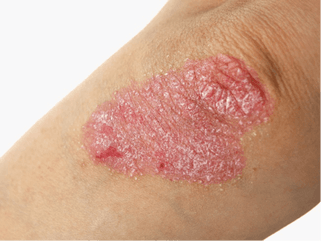 PSORIASIS – Psoriasis is an annoying and sometimes disfiguring rash that most commonly occurs on the elbows,
PSORIASIS – Psoriasis is an annoying and sometimes disfiguring rash that most commonly occurs on the elbows,
knees, scalp, and back. Psoriasis typically takes the form of raised red plaques with a white sheen and covers a large area, though a number of other forms can occur. Conventional treatment usually involves steroid creams; the use of drugs typically reserved for cancer, such as methotrexate; immunosuppressive agents, such as cyclosporine; and nasty (and costly) intravenous agents such as etanercept and infliximab. Treatment can go on for years, even decades, and is plagued by incomplete responses. Psoriasis can be yet another form of immune reaction to fragments of gliadin and other grain prolamin proteins. While psoriasis has also been associated with celiac disease, it can occur without celiac disease and can be associated with an increased likely hood of a positive (IgA) antibody to gliadin. Wheat germ agglutinin (WGA) blocks vasoactive intestinal peptide (VIP), this permits the skininflammation of psoriasis to emerge. A diet absent wheat, rye, and barley has been shown to be effective in improving psoriasis, particularly in people with higher levels of the IgA antibody to gliadin. The Wheat Belly experience has provided relief to countless psoriasis sufferers, the majority of whom enjoy improvement or complete relief from rashes, though it sometimes takes months to achieve compared to the much more rapid response in cases of seborrhea.
ECZEMA – The term “eczema” is applied to a wide range of rashes that are typically red, itchy, and raised and can or occur anywhere on the body. Eczematous rashes are common; one third of the world’s population have experienced or will experience an episode at sometime in their lives. Because eczematous rashes are, to some degree, driven by allergic processes, other allergic phenomena typically accompany eczema, such as asthma, allergic rhinitis and sinus congestion, acid reflux, eosinophilic esophagitis (esophageal inflammation) infantile colic, and allergic enterocolotis (small intestinal and colon inflammation).
People with celiac disease are three times more prone to eczema than people without celiac disease, while relatives of people with celiac disease (who don’t have celiac disease themselves) are twice as prone. Here’s the link to corresponding study.
Because eczema is common outside of celiac disease, there is no shortage of wild theories that blame this chronic, annoying, and sometimes disfiguring condition on everything from dust mites to neurosis to excessive cleanliness. As with any condition that is common and “unexplained,” we should always ask whether consumption of seeds of grasses might be at fault. Eczema has indeed been associated with various foods, including peanuts, dairy, soy, fish, and eggs, as well as all grains. Wheat, rye, and barley contain a smorgasbord of proteins that have been associated with eczema, asthma, and other forms of allergies. It remains unclear just what proportion of people with eczema can blame grains. Judging by the number of people who report relief from eczematous rashes within 5 to 7 days of giving up wheat and/or all grains, the effect wheat has upon this condition is substantial.
APHTHOUS STOMATITIS – This a mouthful of a disease, more commonly known as mouth full of ulcers or canker sores. This can range from a minor annoyance to a debilitating condition that is sometimes so painful that it interferes with eating and speaking. This condition is really a mixture of responses triggered by different causes, and there is an increased incidence in people with celiac disease. However the gliadin and related proteins of grains are among the causes, and a surprising proportion of non-celiac sufferers experience relief from guess what? That’s right: adopting a grain-free diet!
The number of skin conditions caused by grain consumption are simply too numerous to list in detail here, literally numbering in the hundreds. This is not to say that grains cause all skin conditions, but an astounding proportion of them are. And what other potential cause is so easy to correct, no nasty oral or intravenous drugs required, while providing an impressive list of other health benefits?
The post Could that rash be from wheat? appeared first on Dr. William Davis.
Wheat Belly: Ten Rules for Healthy Eating

A hundred thousand years ago, you’d have no doubt what and how to eat. You would wake up every morning, grab your spear, club or axe and go kill something, wander and gather berries, nuts, or dig in the dirt for roots and tubers, or set traps for fish and reptiles. If you succeeded in the hunt, you would consume every organ that included thyroid, thymus, pancreas, stomach, liver, as well as meat. You’d drink water from streams and rivers, allow skin surface to be exposed to sunlight. You would NOT shower with soap or shampoo, apply hand sanitizer, drink chlorinated water, consume foods laced with herbicides and pesticides or genetically-modified foods containing glyphosate or Bt toxin, or take antibiotics for a viral infection. You succeeded in diet without knowing anything about calories, fat grams, carbs, etc. but just following instinct and need.
While we’ve enjoyed many technological successes these past 100 years, we have also experienced what it means to be given awful dietary advice that achieves nothing and ruins health and be subjected to healthcare-for-profit. While there is more to health than diet, just getting diet right is crucial. Let’s therefore consider some of the basic truths in diet that help you regain a toehold in health and weight. If you want to eat for health, not to satisfy some ridiculous food pyramid or plate scheme crafted by commercial interests, then you should:
Eat real, whole foods—Opt for an avocado or egg over protein powder or meal replacement shake or frozen dinner. A meal replacement shake is never an adequate replacement for the nutrient profile of real food.
Never count calories—Of all things, the Biggest Loser TV show illustrated what happens when you restrict calories. Extreme exercise combined with limiting calories does indeed allow weight loss, even to extravagant degrees, in the beginning . . . only to be followed by regain of all the weight when your body adapts by reducing metabolic rate. Nearly all Biggest Loser successes regained all the weight they lost despite maintaining a calorie-restricted diet. Limiting calories is misery and is ineffective for long term weight loss success.
Don’t limit fat—Just as a wild human enjoying a fresh kill does not say “Just give me some of the lean meat and throw out the fat,” so you should never buy lean meats, trim the fat off meats, or turn away butter, olive oil, the oil left after cooking bacon, or coconut oil. Yes, throw away the corn, cottonseed, and safflower oils that corrupt agencies have told you are preferable because they are unsaturated, but don’t limit fats and oils of the sorts that humans have consumed for millions of years and yielded virtually zero heart disease.
Don’t sweat the protein—When you do not limit fats, protein intake is self-regulating. If you feel like having four eggs rather than three, go ahead. If you strength train and feel hungry for more steak, go ahead. Do not count protein grams but follow your appetite and instincts that become reliable without the distortions of wheat and grains. Occasional indulgences in higher protein intake also break ketosis and its harmful long-term effects such as kidney stones, osteoporosis, and diverticular disease.
Ignore diet advice from mainstream healthcare professionals—We have a peculiar situation in which the American Heart Association, the Academy of Nutrition and Dietetics, and other agencies have eagerly accept huge donations from Coca Cola, Pepsi, GlaxoSmithKline, Sanofi Aventis, Merck, Kellogg’s, Kraft, General Mills and other commercial sources, making them willing to craft messages favorable to their donors. These interests in turn “educate” health professionals with messages such as “everything in moderation,” “move more, eat less,” and other ridiculous and ineffective messages. It may be tough, but ignore it all. Their practices have made these agencies irrelevant and counter to your health interests. This also means that, if you saw it in a TV or magazine commercial, don’t buy it. Nobody is advertising eggs from pastured chickens or organic broccoli, so those are the sorts of foods you should choose.
Eat no seeds of grasses—People are often shocked to hear that wheat and grains are the seeds of grasses. For the same reasons you cannot eat the grass clippings from mowing your lawn, you cannot and should not consume the seeds of grasses called wheat, corn, rye, barley, millet, sorghum, etc. as you are incapable of digesting the proteins they contain that thereby exert peculiar immune, gastrointestinal, and mind effects due to indigestible peptides.
Eat nothing with added sugar—Which becomes easy once you have taste perception restored by banishing wheat and grains from your life. You begin to recognize that almonds are actually sweet, as are unsweetened yogurt and Brussel sprouts, while formerly tasty treats like milk chocolate become sickeningly sweet and inedible. There is no reason to add sugar or consume foods with added sugars. The sugar industry may have paid off doctors to conceal the dangers of sugar and divert public attention towards saturated fat, but you should not fall for such commercial shenanigans.
Salt your food—People who are grain-free, as we are in the Wheat Belly lifestyle, need salt. By normalizing insulin blood levels and removing the sodium-retaining gliadin protein of wheat, we actually improve metabolic status by adding salt to our foods, not to mention foods taste better with salt.
Limit dairy—Unlike the seeds of grasses (grains) that have no precedent in dietary consumption and are completely foreign to the human dietary experience, humans are mammals that survive on breast milk for the first two to four years (in primitive societies that follow instinct and not Nestle). But the amino acid sequence of proteins in non-human breast milk are indeed an issue. We therefore limit dairy, choosing fermented forms such as cheese and yogurt that convert lactose to lactic acid and denature (break down) the immunogenic casein beta A1 prevalent in North America.
Drink water—If you were a primitive human hunting for your next meal or digging in the dirt for roots and tubers, you’d stop for a water break at the river’s edge. You would not have access to fruit juices, soda, and the other ways that industry has corrupted beverages. Tea and coffee, being little more than water, are benign. But steer clear of orange juice, grape juice, soda—sugar-containing or aspartamed-up—and opt for the liquid that has sustained humans for millions of years: plain water.
Beyond diet, recognize that modern life has created deficiencies in several nutrients such as iodine, magnesium, and vitamin D that, if not addressed, will limit health success. This is why the Wheat Belly lifestyle is based on eating healthily but goes further in addressing these common deficiencies.
I hope that this list illustrates just how far off-course the modern diet has wandered. Look around you and see the result: obesity, all-you-can-eat buffets, record-setting medical bills, small intestinal bacterial overgrowth in every third or fourth American, and healthcare fat cats profiting from the health and weight disaster. But you know better than that. Follow your instincts. There are no obese squirrels, possum, or lions, yet they don’t follow a food pyramid or plate, don’t have dietitians to guide them, don’t have a health insurance card to cover doctor visits.
The post Wheat Belly: Ten Rules for Healthy Eating appeared first on Dr. William Davis.
February 19, 2019
Muffin Top
Having a “muffin top or “love handles,” i.e., fat encircling the waistline, is not just a cosmetic issue but is a telltale sign that you have visceral fat surrounding your organs such as the liver, intestines, and pancreas. Visceral fat is highly inflammatory and has numerous health consequences from hormonal distortions to diabetes to increased potential for heart disease, dementia, and cancer.
Getting rid of your muffin top and thereby visceral fat is easy, something we do every day in the Wheat Belly and Undoctored programs.
The post Muffin Top appeared first on Dr. William Davis.
February 18, 2019
The Calcium Hoax
You’ve been told by doctors, TV ads, and the nutritional supplement industry that you must take calcium to preserve bone health and avoid osteoporotic fractures later in life. Seems to make sense, doesn’t it? After all, bones are largely made of calcium.
But is it true? No: the evidence tells us that calcium supplementation does not reduce bone thinning, does not increase bone density, and does not reduce fractures. It does, however, at least according to preliminary evidence, increase cardiovascular death, as calcium also goes to the arteries and heart valves. Once again, conventional healthcare botches up health, just as they have with prescribing the wrong diets, choosing drugs over health practices, putting revenue generation ahead of delivering genuine health.
In the Wheat Belly and Undoctored lifestyles, you also become very effective at absorbing dietary calcium, so it becomes especially important that you do not supplement calcium on these lifestyles. The solution to obtaining sufficient calcium is therefore to incorporate all the components of the Wheat Belly or Undoctored lifestyles and obtain all the calcium you need from diet.
The post The Calcium Hoax appeared first on Dr. William Davis.
The Wheat Belly Muffin Challenge
Give it a try: Check your fingerstick blood sugars prior to consuming, then 30-60 minutes after consuming, a conventional muffin, then again with a non-grain muffin made with almond flour, coconut flour, and non-caloric sweeteners such as stevia or monk fruit.
You will see the dramatic differences in blood sugar after each: sky-high with the conventional muffin, no change at all with the non-grain muffin. The difference is crucial: No blood sugar rise means no weight gain, no after-eating fatigue, no inflammation, no contribution to the phenomena of aging. The high blood sugar that results after a conventional muffin (as well as other grain-containing foods) means increased visceral fat, increased inflammation, increased blood sugar, increased insulin resistance that contributes to diabetes, accelerated aging via glycation of proteins. Yes, conventional dietary advice to cut fat and eat more “healthy whole grains” causes weight gain, obesity, type 2 diabetes, autoimmune conditions, and hundreds of other health issues.
This is why in the Wheat Belly and Undoctored lifestyles we are 100% grain-free and do not add sugar to any foods while enjoying magnificent health, slenderness, and youthfulness.
The post The Wheat Belly Muffin Challenge appeared first on Dr. William Davis.
February 17, 2019
Make your family happy
Our L reuteri yogurt triggers your hypothalamus to release oxytocin, the hormone of empathy and connectedness.
People who consume the yogurt are reporting getting along better with partners, spouses, and family members, feeling more empathetic and closer. I therefore encourage everyone to make the yogurt and share with the family and other people who you wish to be closer to.
Consuming our L. reuteri yogurt restores a microorganisms that has been largely lost in modern people. Could this be a contributor to modern social trends such as increasing isolation, record suicide rates, fragmentation of the family, unprecedented divorce rates?
Transcript:
Doctor William Davis here, author of the Wheat Belly and Undoctored books. I want to you today about a way that you can make your family happier — people get along better, empathize with each other.
Screen text: LACTOBACILLUS REUTERI YOGURT
It starts with our Lactobacillus reuteri yogurt. If you don’t know how to make that, or you haven’t been making it, see my Wheat Belly Blog or Undoctored Blog for a post that’s called Making L.reuteri Yogurt — r e u t e r i, named after the discoverer of this organism, Dr. Gerhard Reuter from Germany.
So we make this yogurt — and it’s not about yogurt per se — it’s about the bacteria, the specific species and strains we use to ferment yogurt. You follow the directions I present in those blog posts, because we do it in a very specific way, to increase bacterial counts, to very high levels.
You consume a half a cup of this yogurt a day — by the way, it’s rich and delicious. It’s tart. It’s sour. You may have to add a squirt of stevia, maybe some blueberries, or a teaspoon of inulin, to take away some of the sour edge. But it’s otherwise delicious to take. Consume a half cup a day, and among its many fabulous effects, including increase in dermal collagen, reduction in skin wrinkles, increase in muscle, and other effects, the yogurt causes the hypothalamus to release oxytocin.
Oxytocin is the hormone of empathy, and connectedness, and the desire for the company, the companionship of other people. I’m seeing this play out, in many families, where one or more people in the household are consuming this yogurt. They’re saying “I’m less angry. I’m less irritable. I feel closer to my partner, my spouse. My children are better behaved.”
So we’re getting a lot of very interesting feedback, that I think truly can make your family a happier bunch of people, who get along better, because you feel for the other person’s experience. So I encourage you to make this yogurt, and not just consume it yourself, but share it with your family. I think you’re going to see a transformation in the way they act towards one another, and how they empathize with each other.
The post Make your family happy appeared first on Dr. William Davis.
Wheat Belly works . . . unless you make 1 of these 7 common mistakes!

Follow our discussions here and on the Wheat Belly Facebook page, and you will see that newbies make the same mistakes, over and over again. While all of these issues are discussed in the original Wheat Belly book, and even more extensively in Wheat Belly Total Health and Wheat Belly 10-Day Grain Detox books, somehow they missed some crucial pieces of the message. So, to help you avoid such common mistakes that booby trap both health and your ability to lose weight, here is the list.
Don’t make these common mistakes:
Eat gluten-free foods–Gluten-free foods made with cornstarch, tapioca starch, potato flour, or rice flour should not be used in place of wheat or other gluten sources. This is replacing a problem with another problem. You already know that two slices of whole wheat bread raises blood sugar higher than 6 teaspoons of table sugar. Know what’s worse? Yup: gluten-free foods made with cornstarch, tapioca starch, potato flour, and rice flour!
Eat organic wheat–Without herbicides or pesticides, it’s still wheat. Even worse, it’s still likely to be modern high-yield semidwarf wheat, the worst of all. Is organic tobacco healthy to smoke? Of course not. Organic wheat is no better.
Eat traditional strains of wheat–This includes spelt, kamut, Red Fife, Russian wheat, emmer, and einkorn. These are older strains of wheat that predate many of the changes introduced by geneticists and agribusiness. These strains are indeed less harmful than modern semidwarf strains, but they are not harmless. If I had a cigarette that posed 50% less risk of heart disease and cancer compared to conventional cigarettes, is that good enough for you? Probably not, but that’s how it goes with these traditional strains of wheat, too: less harmful, not harmless.
Find unhealthy grain substitutes–Outside of the awful gluten-free flours, people will often turn to quinoa, buckwheat, or brown rice flour, even more exotic replacements such as teff or millet. While none of these alternatives have the potential like wheat to trigger autoimmune diseases, mind effects, neurological impairment, psychiatric disease, and gastrointestinal disruption, they still send blood sugar sky-high. As with gluten-free flours, don’t replace a problem with another problem.
Mistake gliadin-derived opiate withdrawal with “need”–Stop the flow of wheat and you stop the flow of gliadin protein-derived opiates and you experience the nausea, fatigue, depression, and headaches of opiate withdrawal. People will sometimes interpret this to mean that you body somehow must “need” wheat—no, it is an opiate withdrawal that you must get through to be freed of the grip that Gliadin-derived opioid peptides have over your mind and emotions.
Remain fearful of fat–Cutting total and saturated fat are corollaries of the “eat more healthy whole grain” message: We reject both. But many people have a hard time with this, having endured 30 years of low-fat messaging and products. This is represented by all the people who have lots of hunger or cravings with wheat elimination. So eat fat: buy fatty cuts of meat, eat the fat on pork and beef, eat the dark meat and skin on poultry, save drippings to use for cooking, save all bones to boil for soup or stock and don’t skim off the gelatin or fat when it cools, use more organic butter or ghee, use more coconut oil, eat more avocados, eat the yolks in eggs. This induces satiety and does NOT cause heart disease.
Inadequate hydration–When you stop consuming all things wheat, insulin levels plummet. This permits water loss. If you lost, say, 5 pounds your first week, around 2 or 3 pounds during that first week can be water loss. This can leave you dehydrated. We compensate by hydrating more than usual that first week or so. As salt is also lost in the urine, adding back a mineral rich form of salt, such as sea salt, is also important.
And, for full benefit, don’t let your efforts end at diet. We address a number of important nutritional deficiencies in the Wheat Belly lifestyle—not because the lifestyle causes deficiencies, but because modern life is associated with several deficiencies that impair health. You’ll find the full programs outlined in Wheat Belly Total Health, Wheat Belly 10-Day Grain Detox, and Undoctored books.
It’s really not that tough. Millions of people are now wheat-free and follow the Wheat Belly lifestyle, many more millions will adopt this style of living. With it, we witness a dramatic tidal wave of health transformations—so don’t botch it up!
The post Wheat Belly works . . . unless you make 1 of these 7 common mistakes! appeared first on Dr. William Davis.
February 16, 2019
Nitrates, nitrites, and nitrosamines

There seems to be a lot of confusion about the issues of nitrates, nitrites, and nitrosamines, so much that some people—including book authors and doctors—are declaring that they are entirely benign and not an issue for health. Let’s try and clear up the confusion.
Much of the confusion stems from the fact that nitrates and nitrites occur in many foods, including vegetables and fruit. Upon ingestion, nitrates and nitrites are converted to nitric oxide, the master vasodilator (artery relaxing agent) that thereby contributes to healthy arteries and blood pressure. So there is nothing intrinsically wrong with nitrates or nitrites that are ingested via food.
Ah, but here’s the problem: When heated, nitrites react with the NH3 (amine) group on proteins and yield nitrosamines and other N-nitroso compounds such as N-nitrosodimethylamine, NDMA. We have plenty of experimental evidence that the 20+ known nitrosamines, including those from cigarettes, are potent carcinogens. There is also emerging evidence that N-nitroso compounds are associated with Alzheimer’s dementia.
The human evidence linking N-nitroso compounds with cancer is observational and epidemiological. While I criticize over-reliance on observational data that too often leads to mistaken conclusions in nutrition, in this area we will never have clinical trial data, as it would be unethical. To prove whether or not the carcinogenic observations made via observational epidemiological studies hold true in a clinical trial, we would have to have a group of people ingest nitrosamines and another group not ingest nitrosamines and see who gets more cancers—obviously, this will never be done. So, in this instance, it is unreasonable to demand that we generate clinical trial confirmation of the observational data, although that is what we do in the area of nutritional epidemiology. Can’t do that in cancer. But this is the same level of evidence that we have for glyphosate, radon, and asbestos as carcinogens.
So we are left with plenty of experimental data and weak observational data that suggest that sodium nitrites that react with proteins upon heating may be carcinogenic. That’s as solid as the argument gets—but it’s good enough for me.
It means that, as I discussed in the Wheat Belly and Undoctored books, we steer clear of meats containing sodium nitrite to avoid inducing creation of N-nitroso compounds upon heating.
The post Nitrates, nitrites, and nitrosamines appeared first on Dr. William Davis.
February 15, 2019
Pork Fried “Rice”
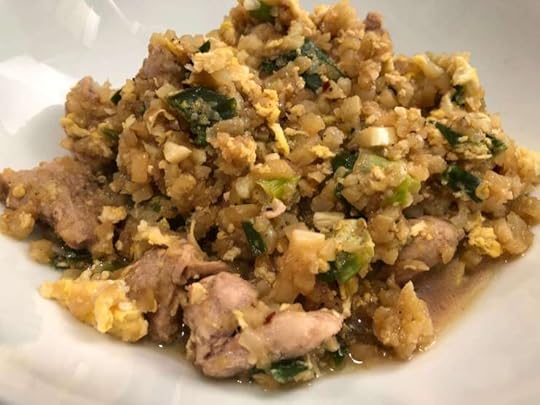
Here’s a recipe from my Wheat Belly 10-Minute (Or Less!) Cookbook, the Light Meals and Side-Dishes section.
If you miss the pork fried rice that you used to order at Chinese restaurants, here is a way to recreate it using healthy ingredients with none of the common problem ingredients like MSG, wheat, cornstarch, or rice.
To save time and effort, look for pre-riced cauliflower. Also, feel free to use as much healthy oils as you like, since we never limit fats or oils.
Makes 4-6 servings
1 head cauliflower, broken into large pieces, or 16-ounces pre-riced cauliflower
2 tablespoons coconut oil, divided
4 scallions, sliced
2 cloves garlic, minced
2 eggs, whisked
1/2 pound pork tenderloin, cut into 1/2-inch cubes
1/4 cup tamari or gluten-free soy sauce
Salt and ground black pepper to taste
Using a food processor with a shredding disk attachment or food chopper or the largest holes of a box grater, shred the cauliflower. Place in a microwaveable bowl. If using pre-riced cauliflower, just add to the microwaveable bowl. Cover and microwave on high for 4 minutes, stirring once, or until desired doneness (similar to the texture of rice).
Meanwhile, in a wok or large skillet over medium-high heat, heat 1 tablespoon of oil until hot. Cook the scallions and garlic for 2 minutes. Add the eggs and stir continuously until cooked through and lightly browned. Remove the egg mixture to a bowl and set aside.
Reduce the heat to medium. Add the remaining 1 tablespoon oil to the wok or skillet. Cook the pork, stirring frequently, for 5 minutes or until no longer pink and exterior lightly browned. Stir in the tamari or soy sauce, steamed cauliflower, and the reserved egg mixture. Cook, stirring, for 2 minutes or until heated through.
The post Pork Fried “Rice” appeared first on Dr. William Davis.
February 14, 2019
My favorite healthy eating and weight loss app for the Wheat Belly Lifestyle
It can sometimes be overwhelming to begin a new way of eating, or as we say, “woe.” The Wheat Belly lifestyle, my grain-free and low-carb, high-fat nutrition plan, can take time and practice. But I say “Time well spent!”
The Wheat Belly lifestyle has been shown to improve insulin sensitivity and reduce inflammation. It also retrains your mind and body to no longer depend on carbs and frees you from the proteins in grains that keep you feeling hungry and damage overall health.
Cut out the wheat, the gliadin and gluten–and all grains– and you reduce the risk of many chronic diseases as well as lose stubborn pounds and look years younger. You dramatically slash chances of getting a long term illness like type 2 diabetes, and feel better in the process!
Remember, total mastery of the Wheat Belly lifestyle isn’t something you do in a day or a week. Or even, for some, in a month.
Eating to remove the grain toxins from your body is just the first step. What comes next is the process of healing your microbiome, hormone and nutrient balances in your body, while reversing inflammation and losing weight.
Luckily, for every step of the way, there is an amazing healthy eating app that can help you on your journey with my Wheat Belly 10-Day Grain Detox called Suggestic.

Welcome back, Suggestic
I hope you were able to tune into my Facebook Live event on February 13th. It was a great kickoff for my latest Challenge. And I was able to give you guys the news on Suggestic.
It’s been a little while since I checked in with my friends at Suggestic–they developed this neat iPhone app for the Wheat Belly 10-Day Grain Detox.
I love it. You guys had great things to say about it when we launched a little more than 6 months ago. Your feedback was invaluable.
Diets can be confusing and it’s always nice to take the guesswork out of following any new way of eating, even one as simple as my Wheat Belly 10-Day Grain Detox. Lots of times I hear questions like, “How will I know when I’ve hit my carb limit? Or, “Where can I get a quick bite that will be grain-free?”
Suggestic helps you through the Wheat Belly 10-Day Grain Detox in all sorts of ways:
even more healthy food choices
daily suggested recipes
a restaurant locator to identify healthy restaurants consistent with our lifestyle
customizable recipes and meal plans
And there’s more good news. Suggestic folks listen. You shared your ideas and they heard you! They made many upgrades.
Intuitive new meal planner will guide you through every day of the Detox for maximum results
Instant grocery lists– select, tap the shopping cart and, voilà, you’ve got a convenient shopping list for when you’re at the market
Logging meals is super easy. Select, add and watch as your net carbs are instantly totaled. Plus, you can track the 6-hour window that’s so important to wait while your gut processes your food. No more guessing about what to eat, when or how much

So follow the Wheat Belly 10-Day Grain Detox with Suggestic. Go to the Apple app store and download the Suggestic diet app onto your phone–it’s free!
Select my Wheat Belly 10-Day Grain Detox, and this wonderful Premium plan is unlocked. You will learn about how to prep for the Detox, what to eat and what to avoid, locate restaurants that have Wheat Belly grain-free options on the menu, and much more.

Taking my Wheat Belly 10-Day Grain Detox on Suggestic can help you log the aspects of your lifestyle that yield the most success.
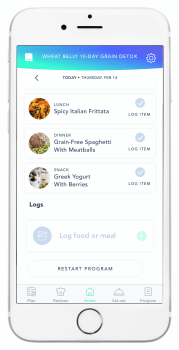
My Favorite Features
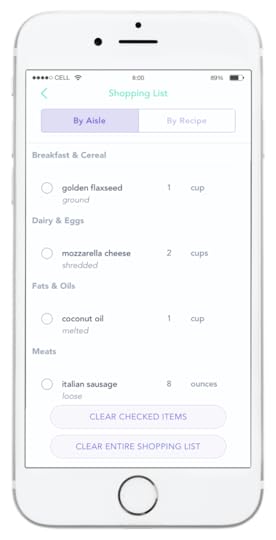
You can log the meals you’ve eaten and track your net carbs– the one and only measure I emphasize in this program–so you’re never wondering how you are doing.
If you’re super busy like I am, you will especially love the grocery list feature. Just tap on the food basket icon and the shopping list for your selected recipe appears. Once you purchase the item, cross it off the list.
Or you can select the breakfast, lunch, dinner, and snacks for your meal plan, then create shopping lists. So easy!
You can further personalize your suggestions by adding filters. Don’t like onions? No problem (neither do I!). Just select onions as a food to avoid and Suggestic will filter onions out for you. That means you won’t see any recipes or restaurant meals that contain onions.
When you sign up for my Wheat Belly 10-Day Grain Detox with Suggestic, the extra guidance is amazing. Each day you will receive a fresh set of reminders and supportive emails (if you wish).
You’ll also have access to exclusive recipes that are specially formulated to keep you deliciously full–remember, this Detox is not about counting calories! Suggestic aims to solve many of the challenges people face when adopting a grain-free diet.
It is a comprehensive grain-free app that guides you in creating the best plan for your health.
Each day, you will track how you eat on Suggestic. Once more, the goal is to have no wheat, corn, rice, oats, barley or other grains whatsoever. Also, you will sharply scale back on sugar and other selected sources of carbs. On average, your total net carbs (total carbs minus fiber) per meal should not exceed 15 grams. With the Suggestic app, your net carbs are calculated the second you log your meal.
We NEVER count calories, so feel free to eat healthy fats and proteins–the app will provide you with endless delicious food choices. To compensate for deficiencies of modern lifestyles (not of the diet), you will need to supplement your diet with magnesium, iodine, fish oil, vitamin D, salt–yes, salt–and water.
Follow my rules throughout the Detox and you will have great success. After the first few days, with the help of this awesome diet app, the beginning stages become much more manageable.
Every day you will be guided with task lists, emails, instructional video, and lots of food options. If you’re more independent, know that these are optional and you can always pick and choose your way through the recipes, ingredients, and other elements–it’s all meant to support you, not hinder you.

Use Suggestic and Get Results!
I have come to realize how helpful my iPhone actually is in keeping my lifestyle organized and on track. (And don’t worry if you don’t have an iPhone. Suggestic will have an Android version soon. In the meantime, you can get all the latest Wheat Belly lifestyle updates on my website or sign up for my newsletter.
Having Suggestic is super important because it reduces the stress of navigating through a grain-free, healthy lifestyle in a world that is packed with grains and unhealthy foods. I recommend getting the app and signing up for my Wheat Belly 10-Day Grain Detox. Experience for yourself what I’m so excited about. Once you sign up and put it to work every day, you’ll never regret it.
The post My favorite healthy eating and weight loss app for the Wheat Belly Lifestyle appeared first on Dr. William Davis.
Dr. Davis Infinite Health Blog
Recognize that this i The insights and strategies you can learn about in Dr. Davis' Infinite Health Blog are those that you can put to work to regain magnificent health, slenderness, and youthfulness.
Recognize that this is NOT what your doctor or the healthcare system provides, as they are mostly interested in dispensing pharmaceuticals and procedures to generate revenues. The healthcare INDUSTRY is not concerned with health--you must therefore take the reins yourself.
Dr. Davis focuses on:
--Real, powerful nutritional strategies
--Addresing nutrient deficiencies unique to modern lifestyles
--Deep insights into rebuilding the microbiome disrupted by so many modern factors
Follow Dr. Davis here and on social media and you can witness the extraordinary successes people enjoy on his programs. ...more
- William Davis's profile
- 159 followers



